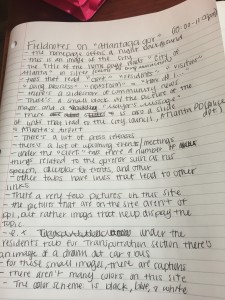
click this image
On April 17th, I began observing Atlanta’s official website. I began studying the site at 10 pm and ended my observation at 11 pm. When observing this site the first thing that caught my eye was the background of the homepage. The homepage offers a night view of downtown Atlanta. The title of the homepage reads “City of Atlanta”. The first two words are in white while the word “Atlanta” is in silver. This seems to bring some type of attraction to the homepage.
The color of the texts are blue and they are easy to read on a white background of the different pages. Included on the homepage is the different tabs that informs people of business, tourists, or people who may move to Atlanta, about the city. Some of the tabs read ” Government” , “Visitors”, and “Doing Business”. Below the tabs are slideshows of community news with a small area with a message from the mayor. There is also a slide a slide of links that lead to information about the “Atlanta PD (police department” , “City council”, etc. At the bottom of the home page there is a calendar for press releases and meetings/upcoming events.
After observing the homepage, I began to navigate through the tab. The navigation for this site was easy. The tabs include sections and in these sections are links to information about the tab. For example, under the “Residents” tab regarding the household section there are links that give the researcher more information about the particular section. This website constantly displays this method rather than the page on the website being just about that tab or section like a traditional website.
The website does not include very many photos. Majority of the images are drawn out. It seems that if there were more realistic pictures especially of people interacting; the website would seem more attractive. An example of the sketched images in under the “Visitors” tab under the “Transportation” section. Once you click on either of the links attached to the images, there’s another page which includes the images and a small caption.

This is a screenshot of the homepage. This is also the overall look for the official website of Atlanta

http://www.atlantaga.gov
The official website for the city of Atlanta was constructed by a number of individuals. This website was constructed to offer information about the city and promote it’s business reputation. This claim can be supported by the “visitor” tab, “doing business” tab, and the home page. The website offers a number of different links to further your knowledge of the city. The intended audience of this website would be for contractors and business men and women.
This source is useful to incoming residents and tourists. The website offers a significant amount of pages that are associated with the website. The website is also update-to-date, which is also useful to a researcher. This helps the researcher to decide how credible the information may be. A weakness for this source is that the contributors are unidentified, but fortunate for the researcher the website is a government official website. This means that all things on the website must be true. The website is also very easy to navigate and this feature is a great benefit to any researcher.
Jen Heilemann. “Women in Tech:Scarcity, Sexism, and Solutions.” The storyexchange. N.p., 9 Apr. 2013. Web.
 Jen Heilemann is a Developer at The Nerdery, which is a company for custom software design and development. Helieman feels “female participation in Computer Science and particularly programming conferences is pitiful” and she offers a link to a number of statistics that support her idea. These links lead to credible sources. She states that “in 1987, 42% of software developers in the US were women, while today, that number hovers around 28%.” “Today” is reference to the year 2013, the reader could question whether these numbers are still active.
Jen Heilemann is a Developer at The Nerdery, which is a company for custom software design and development. Helieman feels “female participation in Computer Science and particularly programming conferences is pitiful” and she offers a link to a number of statistics that support her idea. These links lead to credible sources. She states that “in 1987, 42% of software developers in the US were women, while today, that number hovers around 28%.” “Today” is reference to the year 2013, the reader could question whether these numbers are still active.
The author then talks about how the number of female participants in the industry varies and leads to the “Steve Rule”, blatantly stating there would be greater number of men named “Steve” than female participants. It is said that culture has a lot to do with this, because according to society men and women are suppose to assume a certain role. In the end the author offers incidents to support the claim of sex-based discrimination and she offers some solutions.
This source is useful. It offers good detail and the author offers links in order to support her claims. The article was published in 2013, so some of the information may have updated. I feel this article is very useful looking to discover the effects of gender on digital designs.



